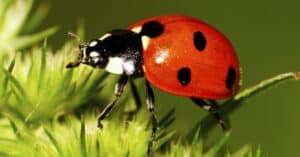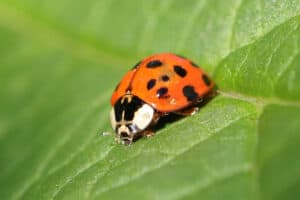Ladybugs belong to the family Coccinellidae, which is a diverse and widespread group of small beetles. Within this family, there are many different genera and species of ladybugs. The exact number of categories or subgroups can vary depending on the classification system used.
While there are many different species of ladybugs worldwide, their distribution and abundance can vary greatly based on factors such as location, climate, and habitat. There are approximately 5,000 different species of ladybugs around the world. So, we won’t list them all.
However, we’ll explore some of the most common and well-known types of ladybugs found throughout the world.
The Most Common Types of Ladybugs by Continent
Listed below are the most common types of ladybugs found on each continent. However, remember there are many other types of ladybugs, many of which are not common or classified.
Africa
Melon Ladybird (Epilachna Chrysomelina)

Control measures for the melon ladybird include the use of insecticides, as well as cultural practices.
©olivier.laurent.photos/Shutterstock.com
The “melon ladybird” or “African melon lady beetle” is an Africa species, also residing in parts of Southern Europe and Asia. It is a pest of cucurbits, including watermelon, melon, and cucumber. If left unchecked, these beetles can cause significant damage to crops. The beetle is around 6-8mm in length and has a mottled yellow and black appearance. Females lay clusters of yellow eggs on the undersides of leaves, and the larvae are yellowish-brown with blackheads.
Control measures for the melon ladybird include the use of insecticides. Cultural practices are also implemented, such as crop rotation and removing crop residues after harvest to reduce the beetle’s overwintering sites. Some natural predators of the beetle include other species of lady beetles, lacewings, and parasitic wasps.
Two-Spotted Ladybug (Adalia bipunctata)
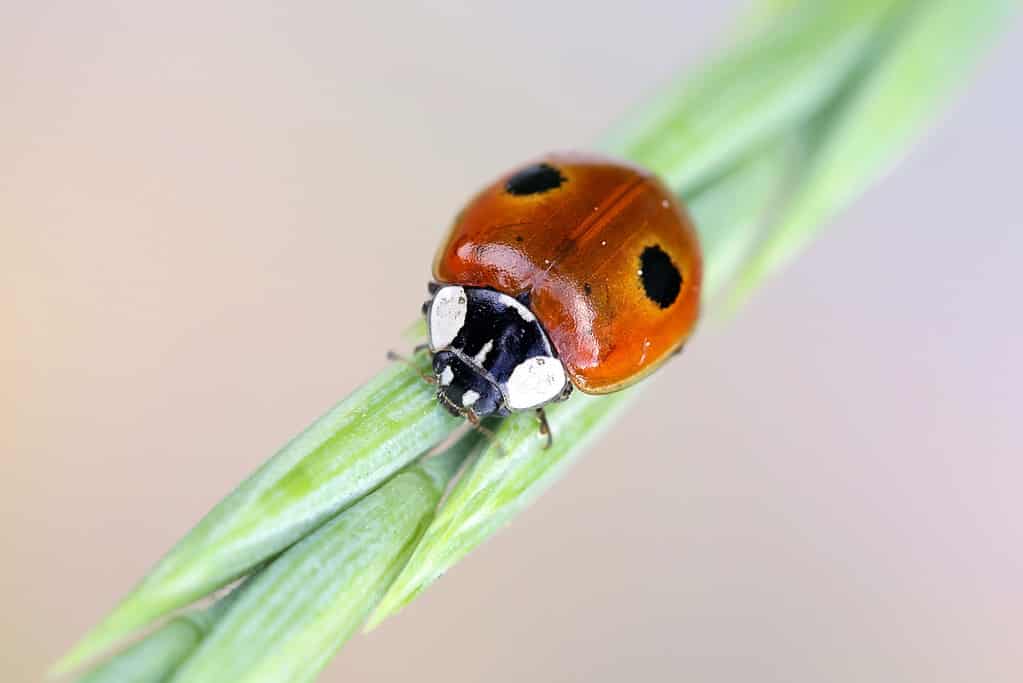
These carnivorous beetles and are known to feed on aphids, mites, and insect eggs.
©Henri Koskinen/Shutterstock.com
The two-spotted ladybug (Adalia bipunctata) is found in various regions throughout the world. This species is easily recognized by its bright orange or red body with two black spots on its elytra (the hard outer wings that cover and protect the hindwings).
They are carnivorous beetles and are known to feed on aphids, mites, and insect eggs, among other small invertebrates. They are valued by gardeners and farmers for their ability to control pests that can damage crops. The two-spotted ladybug has at least three generations per year and is often found on a variety of plants and trees.
Seven-Spotted Ladybug (Coccinella septempunctata)
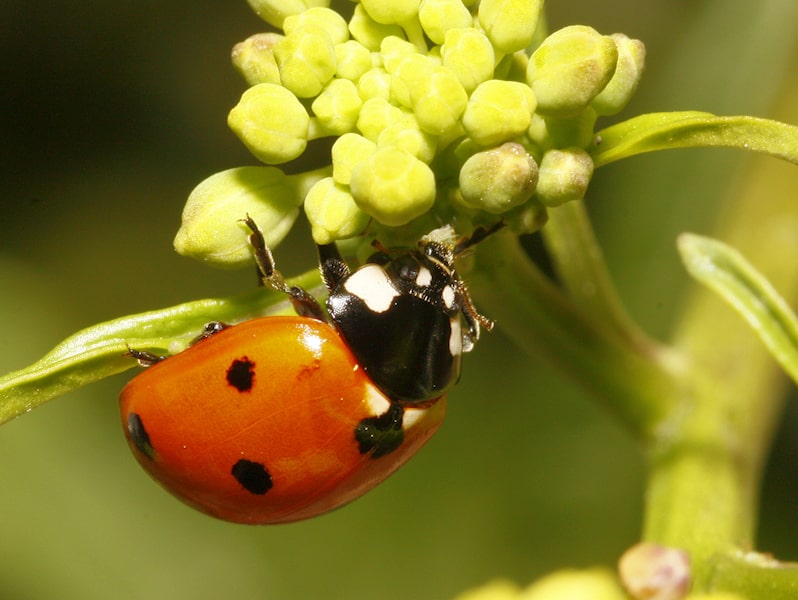
It is easily recognizable by its red body with seven black spots on its elytra.
©798 × 600 pixels, file size: 624 KB, MIME type: image/jpeg – License
The seven-spotted ladybug (Coccinella septempunctata) is among the most common and well-known types of ladybugs in the world. It is easily recognizable by its red body with seven black spots on its elytra. The seven-spotted ladybug feeds on aphids, mites, and other small insects. It is an important natural predator of crop-damaging pests.
Like many ladybug species, the seven-spotted ladybug undergoes complete metamorphosis, with eggs, larvae, pupae, and adult stages. It is frequently used in biological control programs to manage pests in gardens and on farms.
Other Common Types:
The Asian lady beetle (Harmonia axyridis), is an invasive species that has spread to many parts of the world, including Africa. This beetle will be discussed below.
Antarctica
There are no known native ladybug species in Antarctica. The continent’s extreme climate and habitat conditions are generally inhospitable to insects. While humans have introduced some non-native species to Antarctica through scientific research, it is unlikely that ladybugs are one of them. They are unable to survive and reproduce in such an extreme environment.
Asia
Asian Lady Beetle (Harmonia axyridis)
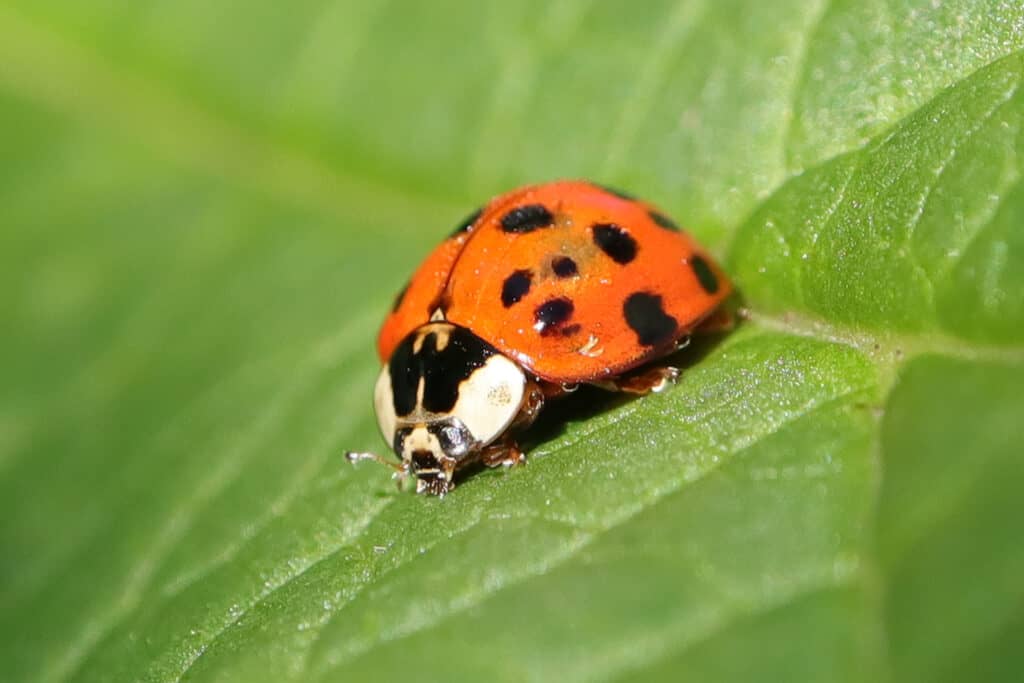
This species is the harlequin ladybug or multicolored Asian lady beetle.
©iStock.com/DE1967
The Asian lady beetle (Harmonia axyridis) is native to Asia but has been introduced to many other regions throughout the world, including North America and Europe. Other names of this species are the harlequin ladybug or multicolored Asian lady beetle, which references its striking coloration. Shades can vary from yellow to orange to red, with anywhere from 0 to 22 black spots.
This beetle is an effective predator of aphids and other soft-bodied insects. However, it has become a nuisance due to its tendency to aggregate in large numbers indoors during the fall months. Some people may also have an allergic reaction to their secretions. Despite this, the Asian lady beetle remains an important biological control agent in many agricultural settings.
Twenty-Two Spotted Ladybug (Psyllobora vigintiduopunctata)
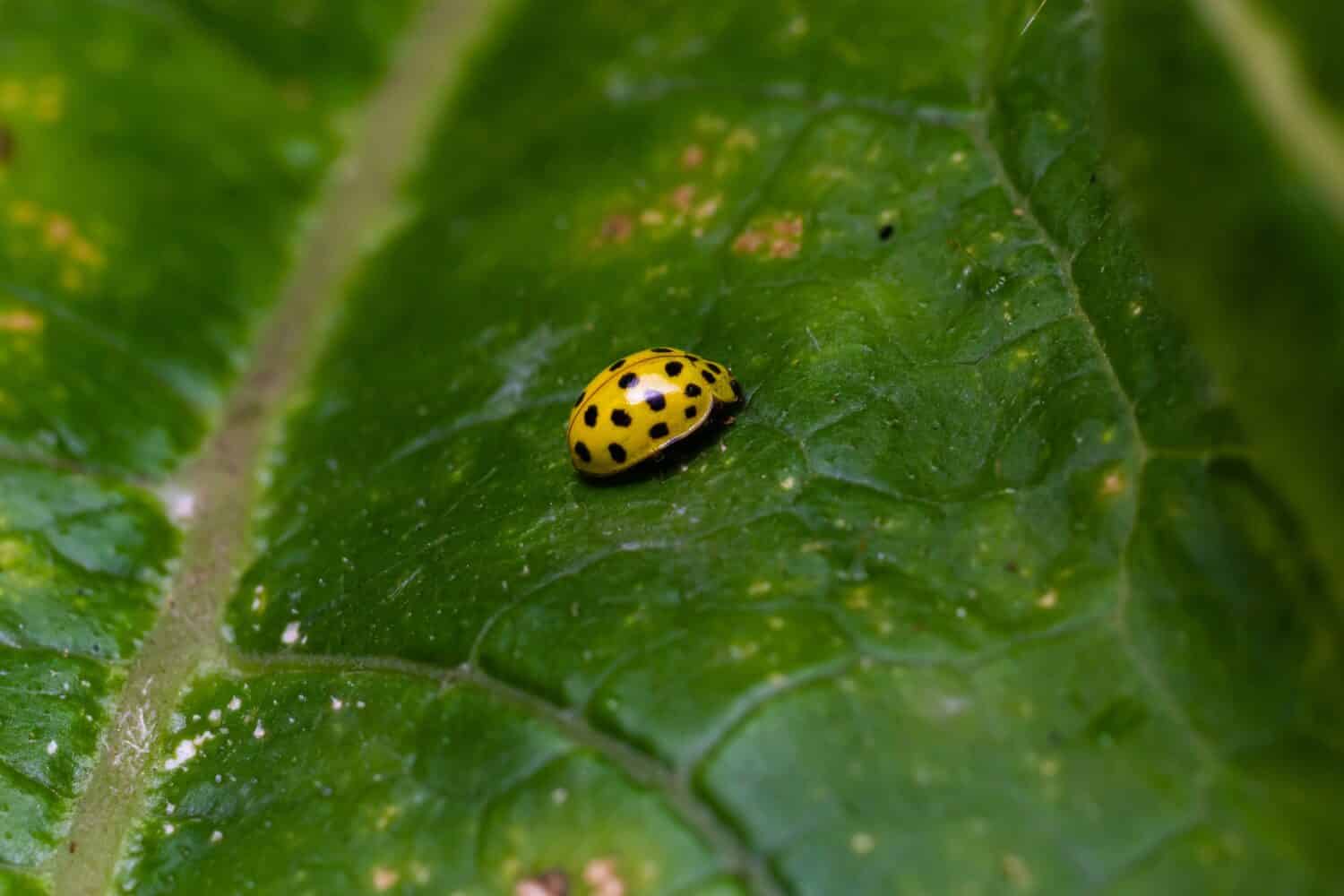
Twenty-two spotted ladybug (
Psyllobora vigintiduopunctata)
©olko1975/Shutterstock.com
The twenty-two spotted ladybug (Psyllobora vigintiduopunctata) resides in parts of Europe, Asia, and North America. As its name suggests, these ladybugs have 22 black spots on their yellow or orange elytra. They are small ladybugs, typically measuring between 3 to 4.5 mm in length.
Twenty-two spotted ladybugs primarily live in deciduous forests but can also hang around in gardens and other wooded areas. These ladybugs feed on a variety of small insects, including aphids, mites, and scale insects. They are an important biological control agent in many agricultural settings. They are also a valuable component of natural ecosystems.
Other Common Types:
Other common types of ladybugs in Asia are the seven-spotted ladybug and the two-spotted ladybug (which we discuss below). The Asian lady beetle in particular is a highly successful and widely distributed species. It has become invasive in many parts of the world, including North America and Europe.
Australia/Oceania
Common Spotted Ladybird (Harmonia conformist)

As an adult, the common spotted ladybird is a predator of other insects and feeds on aphids.
©Cassandra Madsen/Shutterstock.com
The common spotted ladybird (Harmonia conformis) is native to Australia. It can also be found in New Zealand, where it has been introduced. As an adult, this ladybird is a predator of other insects. It feeds on aphids, both as a larva and as an imago (adult). It is an attractive large ladybird with 23 spots on a dark yellow to red base color. The species is important for the biological control of aphids, with adults consuming around 50 aphids per day. The harmonia ladybird beetles have the potential control aphid populations in a variety of situations.
Fungus-Eating Ladybird (Illeis galbula)
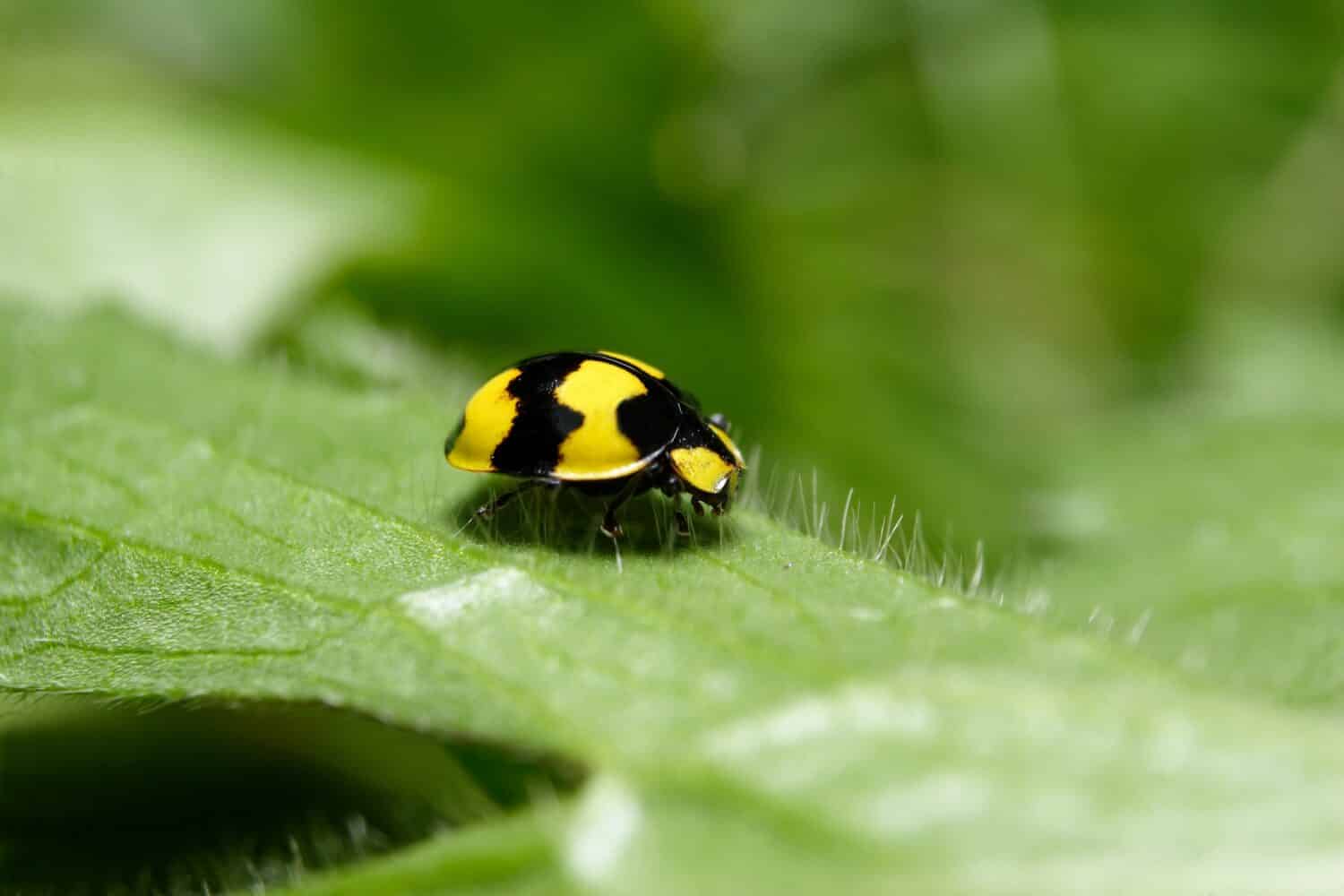
Fungus-eating ladybird (
Illeis galbula)
©Andy Waugh/Shutterstock.com
The fungus-eating ladybird (Illeis galbula) thrives in Australia. As the name suggests, this species primarily feeds on powdery mildew fungi. This behavior makes it an important biological control agent in gardens and farms. Adults are bright yellow with black spots on their elytra. The larvae are between 8 and 10 mm long and are also yellow with black spots.
The fungus-eating ladybird undergoes complete metamorphosis, with eggs, larvae, pupae, and adult stages. It is a valuable component of natural ecosystems in Australia and is a frequent natural control agent in agriculture and horticulture.
Fourteen-Spotted Ladybird (Propylea quatuordecimpunctata)
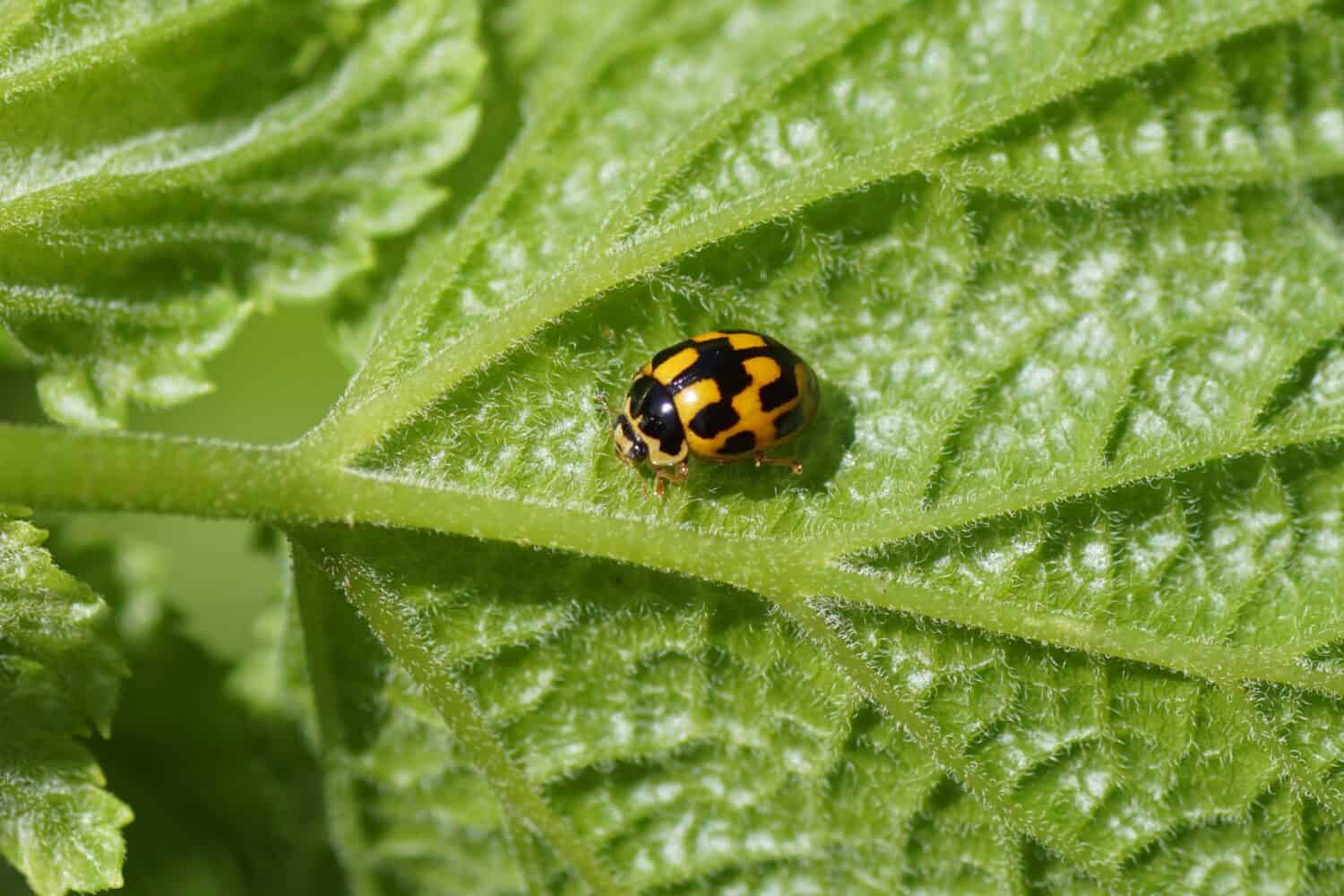
The fourteen-spotted ladybird is a valuable biological control agent, feeding on soft-bodied insects.
©Thijs de Graaf/Shutterstock.com
The fourteen-spotted ladybird (Propylea quatuordecimpunctata) lives in different regions throughout the world. As the name suggests, this species has 14 black spots on its bright yellow elytra. It is a small ladybug, typically measuring between 3 and 5 mm in length.
The fourteen-spotted ladybird is a valuable biological control agent. They feed on a range of soft-bodied insects, including aphids, scales, and mealybugs. They are also sometimes used as a natural control agent in agriculture and horticulture. The larvae are elongated, spiny, and brightly colored in shades of orange and black.
This bug undergoes complete metamorphosis, with eggs, larvae, pupae, and adult stages. Overall, the fourteen-spotted ladybird is an important part of natural ecosystems and a valuable tool for managing pest populations.
Other Common Types:
Many other types of ladybugs are in Australia. For example, the mealybug ladybird (Cryptolaemus montrouzieri) and the transverse ladybird (Coccinella transversalis) are common.
The mealybug ladybird is particularly valuable as a biological control agent, as it feeds on a range of soft-bodied insects, including mealybugs and scale insects. The common spotted ladybird is bright orange with black dots. Meanwhile, the transverse ladybird has two white stripes across its elytra and prefers urban gardens and parks.
Europe
Ten-Spotted Ladybird (Adalia 10-punctata)

Despite its name, ten-spotted ladybirds can have anywhere from zero to 13 spots on their orange elytra.
©Ger Bosma Photos/Shutterstock.com
The ten-spotted ladybird (Calvia decemguttata) thrives throughout Europe and Asia. Despite its name, this species can have anywhere from zero to 13 spots on its bright red or orange elytra. The larvae are elongated slugs, black with white speckles. They enjoy feeding on aphids.
The ten-spotted ladybird is a valuable biological control agent. They feed on pests like aphids, mites, and thrips, making them a useful natural control agent in agriculture and horticulture. This species undergoes complete metamorphosis, with all four stages. It is an important part of natural ecosystems.
Cream-Spot Ladybird (Calvia 14-guttata)

The cream-spot ladybird is small, typically measuring between 3 to 4.5 millimeters in length.
©Akil Rolle-Rowan/Shutterstock.com
The cream-spot ladybird (Calvia quatuordecimguttata) lives throughout Europe and is commonly referred to as Calvia 14-guttata. As the name suggests, this species has 14 creamy-white spots on its maroon-brown elytra.
The cream-spot ladybird is small, typically measuring between 3 to 4.5 millimeters in length, and has brown legs. It is a valuable biological control agent, feeding on a range of soft-bodied insects, including aphids and other small insects.
The cream-spot ladybird goes through all the stages of metamorphosis. It is a unique part of natural ecosystems and helps control pests.
Pine Ladybird (Exochomus quadripustulatus)
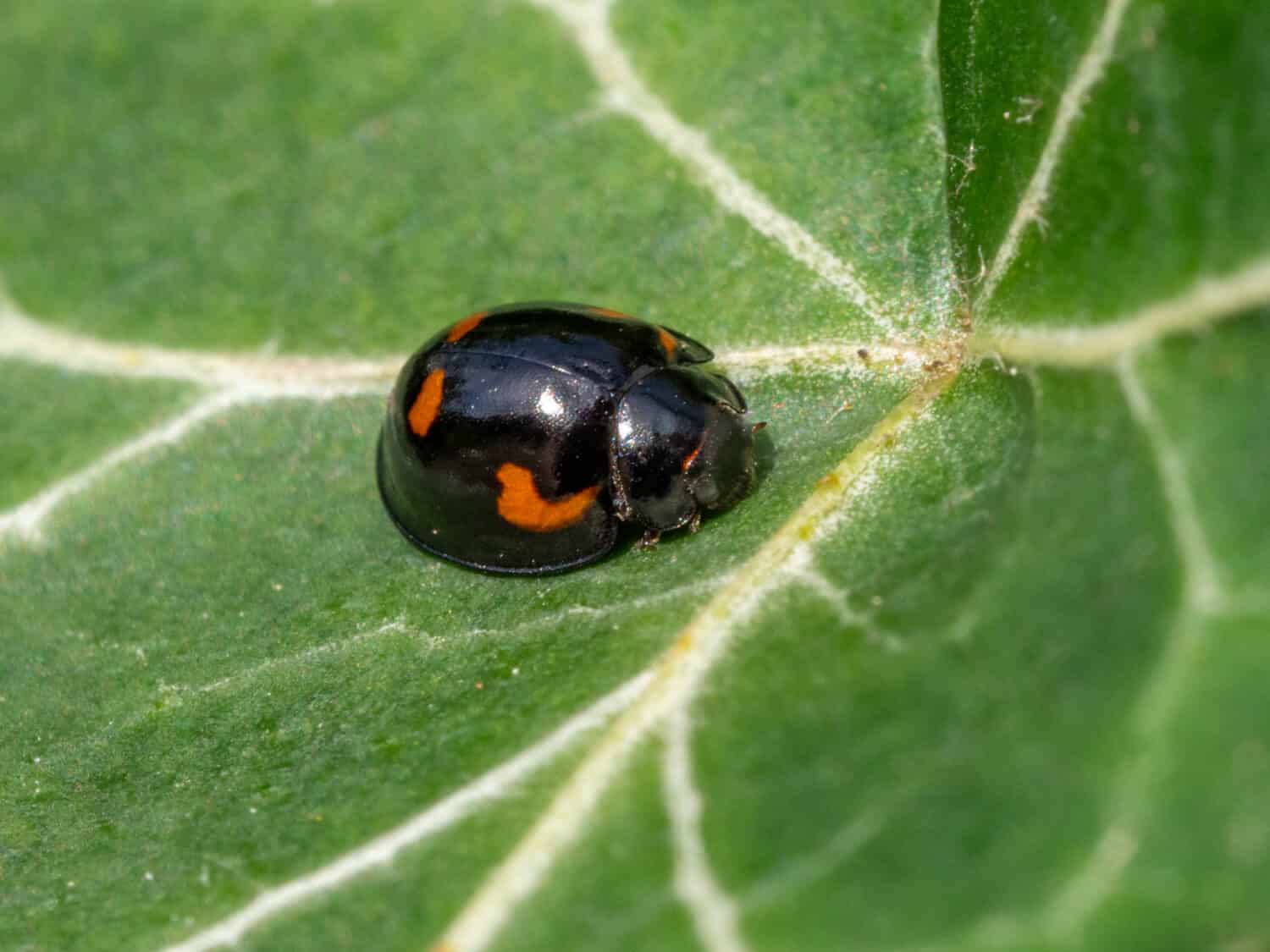
The pine ladybird is brownish red with four black spots on each elytron.
©Keith Hider/Shutterstock.com
The pine ladybird (Exochomus quadripustulatus) is common in Europe. Other names include the pine lady beetle, and this species commonly hangs around on pine trees. However, it can also reside on other conifers as well as deciduous trees and shrubs.
The pine ladybird is a small species, typically measuring around 4mm in length, and is brownish red with four black spots on each elytron. It is a valuable biological control agent. They eat soft-bodied insects including aphids, mites, and scale insects. You can spot them in orchards and gardens.
The pine ladybird completes the stages of egg, larvae, pupae, and adult. It can control pest populations in agricultural and horticultural industries.
Other Common Types:
The seven-spotted ladybug and the two-spotted ladybug (mentioned above) are also common in North America, among others.
North America
Mexican Bean Beetle (Epilachna varivestis)

Unlike most ladybugs, the Mexican bean beetle feeds on the leaves, flowers, and beans of bean plants.
©Muhammad Naaim/Shutterstock.com
The Mexican bean beetle (Epilachna varivestis) is native to Mexico but has since become an invasive species in parts of North America, where it has become a pest of bean crops. Unlike most ladybugs, which are predators of soft-bodied insects, the Mexican bean beetle feeds on the leaves, flowers, and beans of bean plants, causing significant damage to crops. The larvae are yellow with spines.
The adult beetle is oval-shaped, 6mm long, and orange red. They have black spots and a black head. The Mexican bean beetle thrives in North America. Farmers are making an effort to control their populations through natural means, such as insect predators, parasites, crop rotation, and insecticides when necessary.
Convergent Ladybug (Hippodamia convergens)
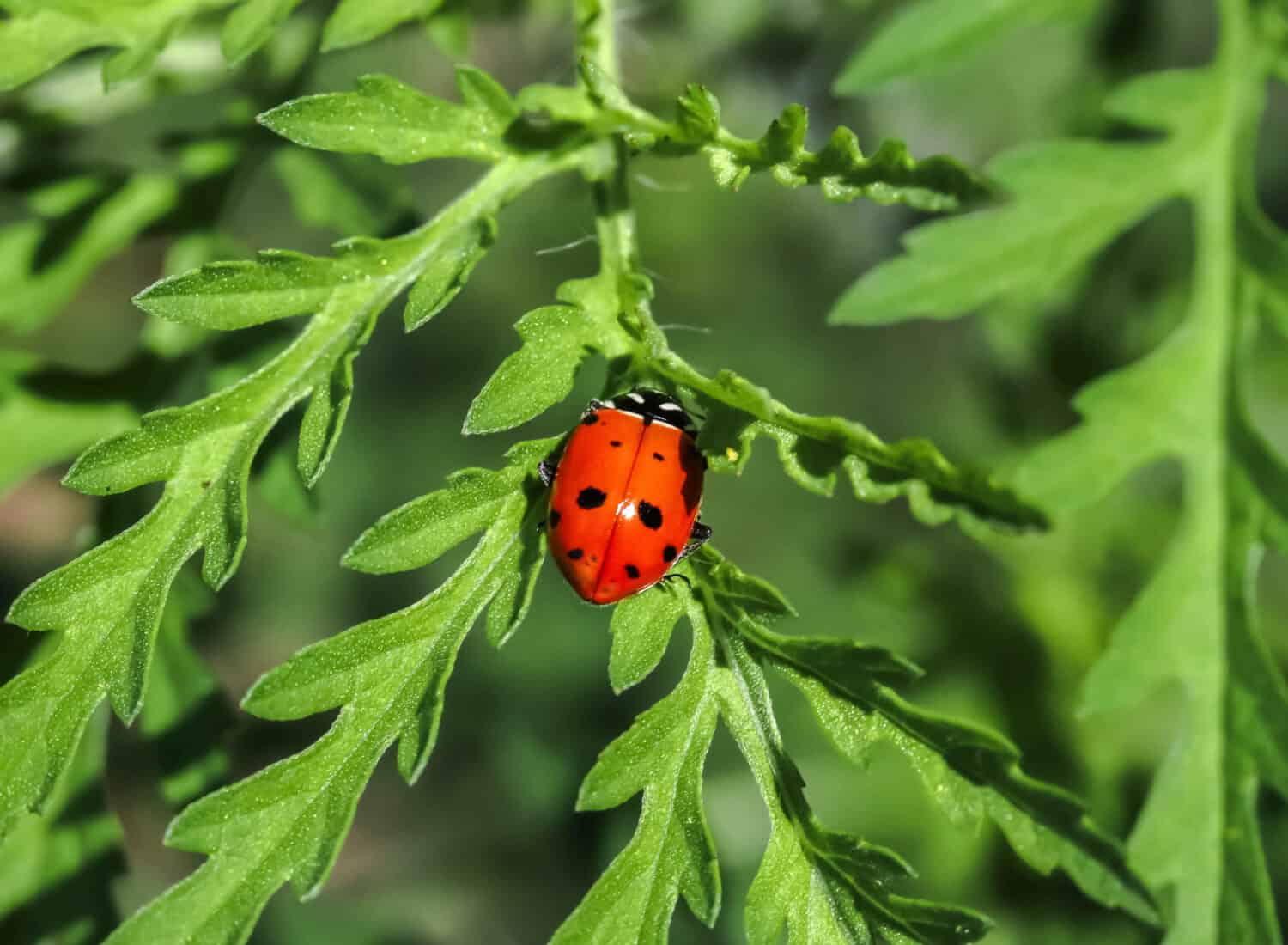
Convergent ladybugs can vary in color, with some individuals being more yellow-orange or entirely red.
©KAPPture Photography/Shutterstock.com
The convergent ladybug (Hippodamia convergens) is common throughout North America. As the name suggests, this species has converging lines on its elytra. Convergent ladybugs are important biological control agents, particularly in agricultural and horticultural settings.
They go through metamorphosis, and the larvae are small, alligator-like, and black with orange spots and spine-like projections. Adults are generally oval-shaped, 5mm long, and red-orange with black spots. They can also vary in color, with some individuals being more yellow-orange or entirely red.
They are a highly beneficial species and are natural control agents for pest management.
Nine-Spotted Ladybug (Coccinella novemnotata)
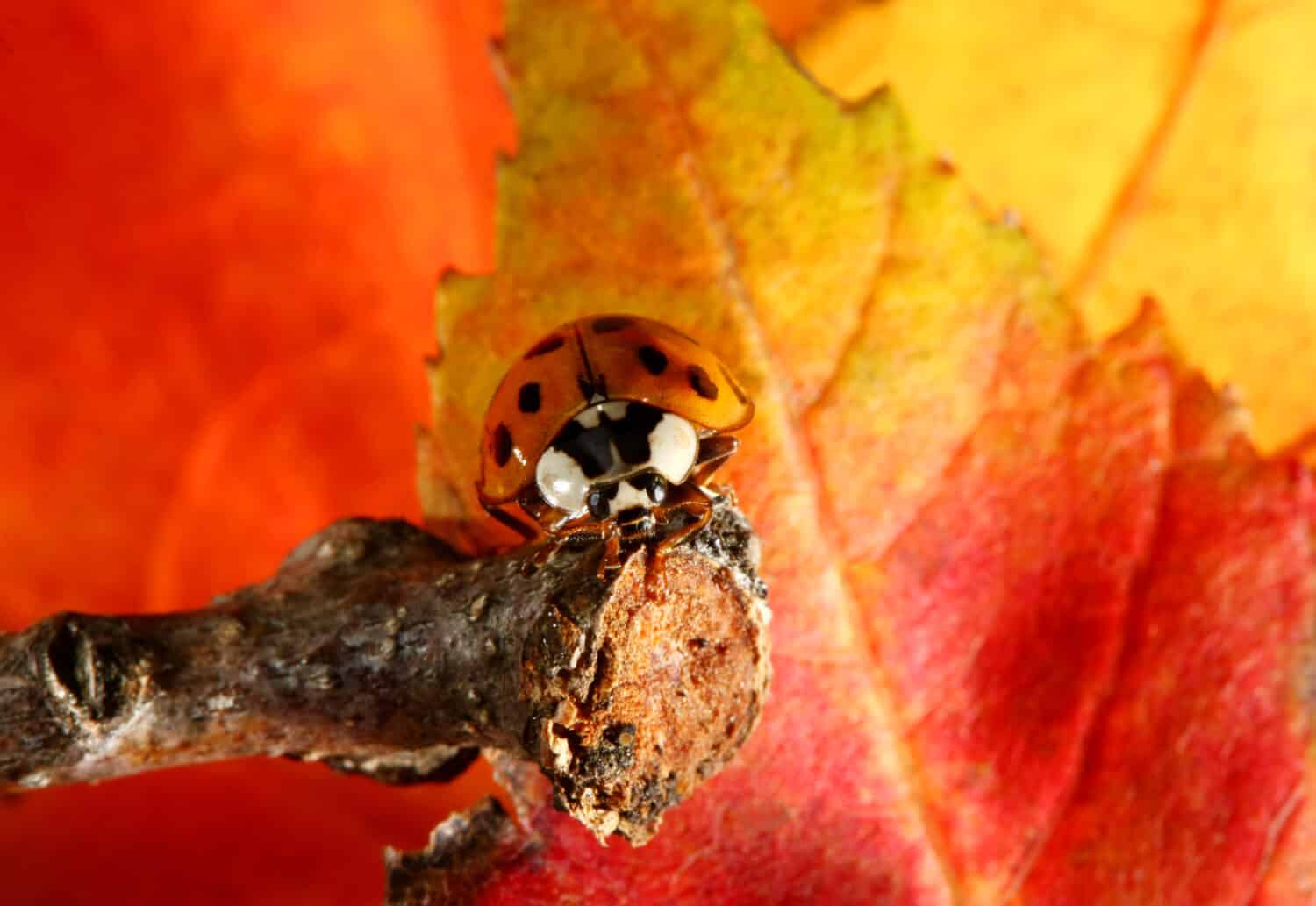
The nine-spotted ladybug is an important biological control agent, preying on soft-bodied insects.
©Steve Bower/Shutterstock.com
The nine-spotted ladybug (Coccinella novemnotata) is native to North America. As the name suggests, this species has nine black spots on its bright red or orange elytra. However, for some beetles, the number of spots can vary from 0 to 10. The larvae have an elongated, alligator-like appearance with orange and black markings.
The nine-spotted ladybug is a biological control agent, preying on pesky aphids, mites, and scale insects. This species is also culturally significant, as the state insect of New York.
Unfortunately, populations of the nine-spotted ladybug have declined significantly over recent years due to habitat loss, pesticide use, and other factors. As such, conservationists are making efforts to save this species and its habitat.
Twice-Stabbed Ladybug (Chilocorus stigma)
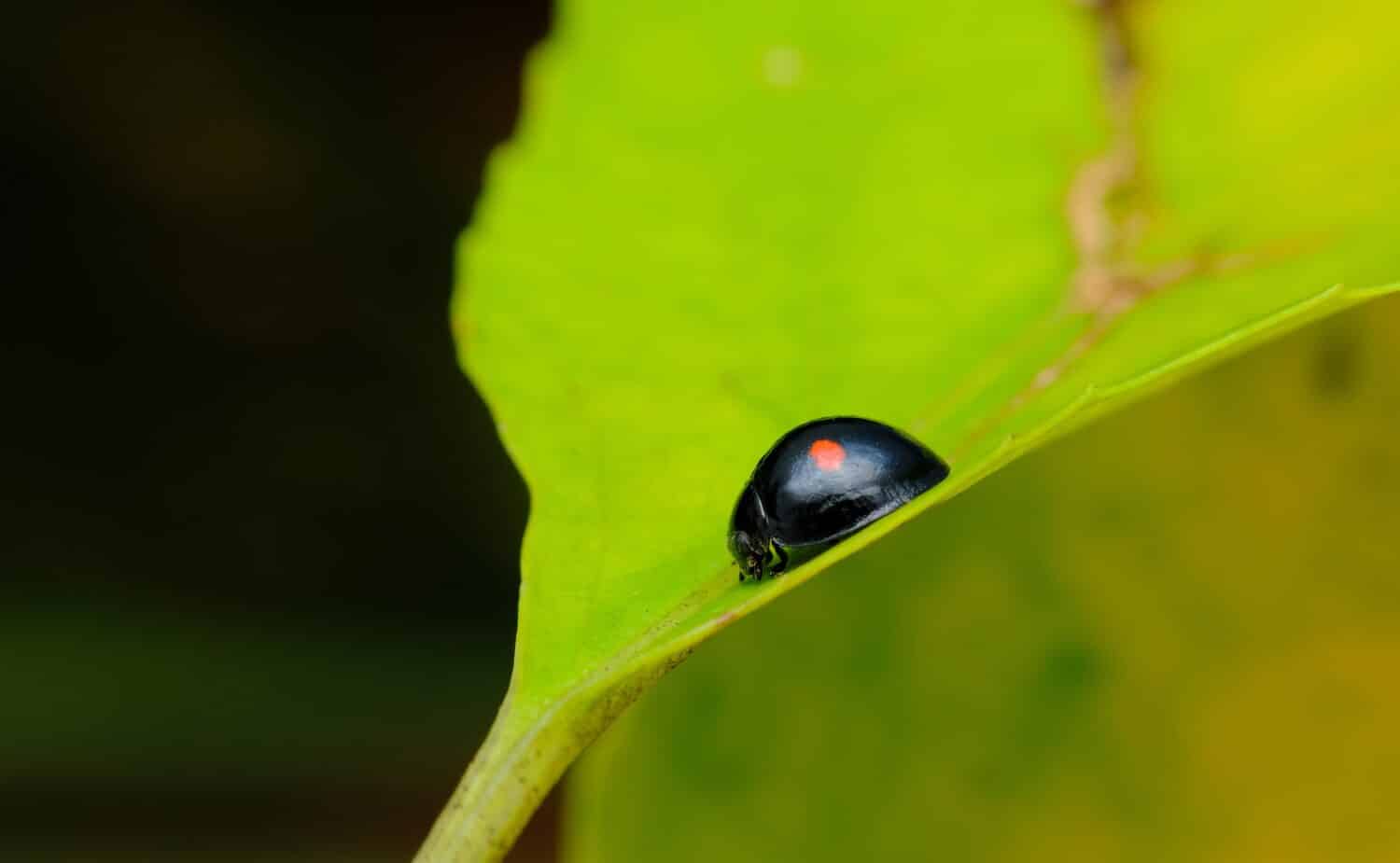
This species is a natural control agent for pests.
©Ezume Images/Shutterstock.com
The twice-stabbed ladybug or lady beetle (Chilocorus stigma) lives in North America. This species has two red spots on its black or dark brown elytra, which gives the appearance of “twice stabbed”. Larvae are black with orange or yellow spots and long, black spines.
Like many ladybugs on this list, the twice-stabbed ladybug preys on aphids, mites, and scale insects.
Other Common Types:
The seven-spotted ladybug and the two-spotted ladybug (mentioned above) are also common in North America. Unfortunately, many native ladybug species in North America have been declining in numbers due to competition and displacement by invasive ladybug species such as the Asian lady beetle (Harmonia axyridis).
South America
Multicolored Asian Lady Beetle (Harmonia axyridis)

Observers can distinguish them by the unique marking patterns, which may be variable.
©Ger Bosma Photos/Shutterstock.com
The multicolored Asian lady beetle (Harmonia axyridis) is home to Asia, but people have introduced them to many other parts of the world, including North America, Europe, and South America. This species is similar in size and shape to other ladybugs. Observers can distinguish them by the unique marking patterns, which may be variable depending on the region and plant species it inhabits. It can be yellow, orange, or red and has a varying number of black spots.
Multicolored Asian lady beetles feed on aphids, mites, and other soft-bodied insects, making them important to the agricultural and horticultural industries. However, they can also become pests themselves, particularly in residential and commercial structures where large numbers of beetles may take shelter. When disturbed, they can release a yellowish, foul-smelling liquid, which can cause stains and odors. Overall, this species has interesting and complex ecological interactions and its introduction to new regions can have significant impacts on local ecosystems.
In Conclusion
Ladybugs are gorgeous with their bright colors and striking patterns. However, they are also a vital part of many ecosystems. Additionally, they do a great job controlling common agricultural pests. Learning about different ladybug species can help us better understand biodiversity and the importance of conservation efforts.
The photo featured at the top of this post is © iStock.com/DE1967
Thank you for reading! Have some feedback for us? Contact the AZ Animals editorial team.




